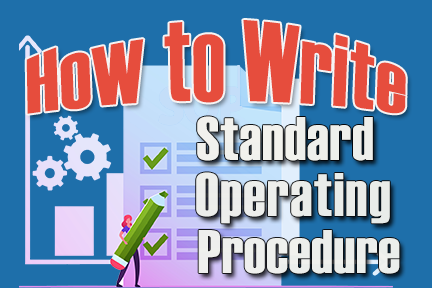 The key step in writing a Standard Operating Procedure (SOP) is making the decision to DO IT!
The key step in writing a Standard Operating Procedure (SOP) is making the decision to DO IT!
Then write down the TOP THREE FRUSTRATIONS in your business. In other words, those problems with job and service workflow affecting your company’s bottom-line.
Not to mention, those issues that keep you awake at night.
Every small business owner knows those places in their operations that are running poorly.
However, many business owners buy the LIE that “some disorder is normal,” and therefore surrender to it. Sadly, they just deal with it.
Don’t join that crowd! In fact, fight ALL disorder, non-conformance and chaos with every fiber of your being.
A wise man once wrote in a letter, “God is not the author of confusion.” Truth is, accepting chaotic disorder as somehow “normal” only leads to more dysfunction.
Steps to Business Freedom
There are three steps you should consider for gaining business ownership freedom.
However, for now we are going to focus on a KEY STEP in writing SOP’s.
For clarity, those whose vision for their business ownership is remaining “Mom & Pop” may not have a desire to write down how their business operates. The reason being, they seem comfortable with having a steady JOB inside the business. They’re okay with keeping operating procedures IN THEIR HEAD. Consequently, when employees have job-related questions, they can simply ask the owner (“Mom” or “Pop”) for the answers. I can tell you, that gets old!
But for those owners who want the freedom NOT to work in the business, and still see the business grow without the stresses that occur with growth, THE ANSWER IS:
Learn to write a Standard Operating Procedure (SOP). It’s worth every invested penny!
This is HOW you should delegate to others!
In fact, having someone use a great Standard Operating Procedure you’ve written is like performing the procedure yourself.
Considerations for Writing a Standard Operating Procedure
When deciding to write a Standard Operating Procedure, consider its priority. In other words, will it improve and/or stop errors and all non-conformance in important workflow locations? You know… the ones that cause you the MOST frustration and pain in your business?
Once addressing and writing SOPs for your top three frustrations, continue writing SOPs for every area of the business, until you correct ALL non-conformance.
Consider the following as you download the way your business operates—out of your head and into Standard Operating Procedures (SOPs):
Context and Understanding
The words used must plainly describe the intended performance of the operation. Whereby, the prompt/step, or call to action, is easily understandable by any member of the organization.
Participation
Before implementing a Standard Operation Procedure (SOP), everyone affected by the document should participate in sharing his or her ideas, or any concerns. Simply put, to consider the SOP’s impact on their job. In addition, all those affected by an SOP should be involved in the testing, revising, and updating of the document.
Standardization
Terminology should be consistent, whenever possible. For example: calling an item a cell phone in one document and then referring to it as a mobile phone in another document. When using hundreds of terms, it gets very confusing. Also, standardize fonts to only one or two. We suggest Arial or Calibri.
Completeness/Comprehensiveness
There must be NO gaps/holes in information, logic, or design. In fact, have someone not part of the writing process to perform each step/prompt in the procedure, to discover where they might get bogged down.
Compliance
Consider implementing a system of follow-up for assuring compliance in the use and performance of all Standard Operating Procedures.
Referencing/Linking
Referencing/linking seldom-used documents to other frequently-used documents is important. This will ensure against losing, discarding, or forgetting those seldom-used documents. Out of sight, out of mind applies here.
FYI: Our own DocDesigner™ has a great linking tool to link documents and systems. Every document can become its own dashboard.
Final Approval
In delegating, the all-important task of building, implementing, and/or updating SOPs, the owner or head of the organization should give final approval. To be clear, owners should know exactly the function and design of all new SOPs or updates.
Remember—the liability for quality service and products starts at the top!
Did I mention? Great systems really do work!

Recent Comments